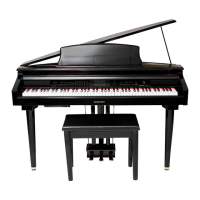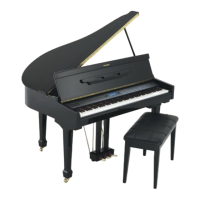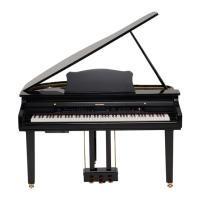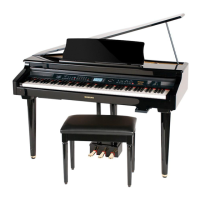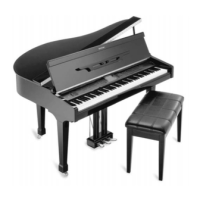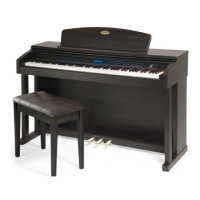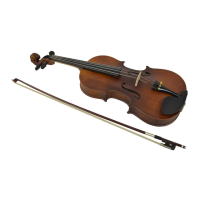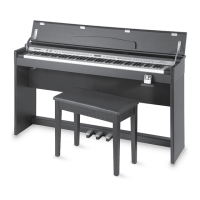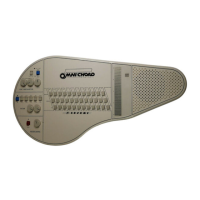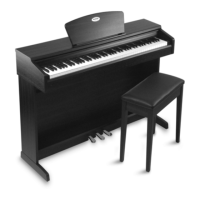Do you have a question about the Suzuki Micro Grand and is the answer not in the manual?
Read, keep, heed, and follow all safety instructions.
Warnings against electric shock, improper power connection, and wet hands.
Precautions regarding chair stability, leaning on keyboard, and product modification.
Notes on FCC compliance, radio frequency energy, and potential interference.
Highlights key features like lacquer finish, sound system, and teaching capabilities.
Covers power source, non-use, service, handling, transport, and cleaning.
Advises on placement to avoid damage and proper power handling.
Explains the power switch, master volume, and tone knobs.
Adjusts the volume of the auto accompaniment section.
Adjusting keyboard volume, pitch, and octave shifts.
Engaging chord accompaniment and synchronized rhythm start.
Controls for starting, stopping, and modifying rhythm patterns.
Adjusting rhythm tempo by tapping.
Using metronome, reverb, chorus effects, and touch sensitivity.
Dividing the keyboard into two sections for different voices.
Exploring layer, harmony, duet playing, and one-touch settings.
Navigating the function menu and confirming selections.
Selecting voices/styles and resetting to default Grand Piano.
Using the numeric pad for input and navigation.
Selecting piano, E.Piano, Vibes, Rock Organ, Strings voices.
Managing user presets and storing settings.
Playing demonstration songs and using left/right hand practice.
Recording tracks, saving performances, and file management.
Using the USB terminal for recording and playback.
Connecting MIDI devices and the pedal unit.
Using USB to host, line outputs, and headphone jacks.
Functions of the three piano pedals.
Turning the piano on/off and setting the master volume.
How to select and play demonstration songs.
Setting rhythm tempo and transposing pitch.
Applying reverb and chorus effects to the sound.
Using the metronome and adjusting keyboard touch response.
Shifting the keyboard pitch up or down by octaves.
Selecting voices using quick select buttons.
Method for selecting any of the 137 available instrument voices.
Assigning favorite voices to the USER button.
Combining voices (Layer) or dividing the keyboard (Split).
Setting the split point for voice separation on the keyboard.
Controlling volumes for split, dual, and main voices.
Choosing and starting rhythm styles.
Using the Chord button and starting/stopping styles.
Understanding how auto accompaniment works with rhythm styles.
Playing major, minor, and seventh chords for accompaniment.
Details on minor-seventh chords and using fingered mode.
A comprehensive table of chord fingerings.
Enhancing melodies with auto harmony notes.
Methods for starting, stopping, and adding fills to accompaniment.
Assigning the split point for auto accompaniment function.
Using One Touch Setting and adjusting accompaniment volume.
Adjusting reverb depth for the main keyboard voice.
Adjusting reverb depth for the split voice.
Adjusting chorus depth for the main keyboard voice.
Adjusting chorus depth for the split voice.
Adjusting chorus depth for the dual voice.
Setting the keyboard split point for voice separation.
Setting the chord point for auto accompaniment.
Selecting different chord types for accompaniment.
Configuring metronome patterns and volume levels.
Adjusting the stereo position for different voices.
Adjusting the instrument's pitch to match others.
Choosing between Duet, Close, and Octave harmony types.
Enabling or disabling the song grading function.
Adjusting song volume and selecting USB playback modes.
Setting the playback speed for USB audio files.
Controlling USB audio volume and muting tracks.
Managing local MIDI sound and MIDI data reception.
Setting MIDI transmission channels and parameters.
Resetting the instrument to its default parameters.
Recording a single performance directly to a USB disk.
Recording performances with multiple independent tracks.
Automatically assigning tracks during recording.
Manually selecting tracks for recording specific voices.
Removing unwanted songs from the USB disk.
Accessing files and adjusting song playback volume.
Storing and recalling voice settings to/from memory.
Handling registration files on USB drives for backup and loading.
Choosing songs and listening to the entire piece.
Isolating and practicing individual hand parts of a song.
Playing along with both left and right hand parts.
Understanding MIDI ports and controlling internal sound.
Turning Local MIDI and MIDI reception on or off.
Technical chart detailing MIDI message transmission and recognition.
Comprehensive list of all 137 instrument voices.
Catalog of the 100 available rhythm styles.
Detailed list of the piano's technical features and capabilities.
Details on warranty coverage, terms, and contact information.
Read, keep, heed, and follow all safety instructions.
Warnings against electric shock, improper power connection, and wet hands.
Precautions regarding chair stability, leaning on keyboard, and product modification.
Notes on FCC compliance, radio frequency energy, and potential interference.
Highlights key features like lacquer finish, sound system, and teaching capabilities.
Covers power source, non-use, service, handling, transport, and cleaning.
Advises on placement to avoid damage and proper power handling.
Explains the power switch, master volume, and tone knobs.
Adjusts the volume of the auto accompaniment section.
Adjusting keyboard volume, pitch, and octave shifts.
Engaging chord accompaniment and synchronized rhythm start.
Controls for starting, stopping, and modifying rhythm patterns.
Adjusting rhythm tempo by tapping.
Using metronome, reverb, chorus effects, and touch sensitivity.
Dividing the keyboard into two sections for different voices.
Exploring layer, harmony, duet playing, and one-touch settings.
Navigating the function menu and confirming selections.
Selecting voices/styles and resetting to default Grand Piano.
Using the numeric pad for input and navigation.
Selecting piano, E.Piano, Vibes, Rock Organ, Strings voices.
Managing user presets and storing settings.
Playing demonstration songs and using left/right hand practice.
Recording tracks, saving performances, and file management.
Using the USB terminal for recording and playback.
Connecting MIDI devices and the pedal unit.
Using USB to host, line outputs, and headphone jacks.
Functions of the three piano pedals.
Turning the piano on/off and setting the master volume.
How to select and play demonstration songs.
Setting rhythm tempo and transposing pitch.
Applying reverb and chorus effects to the sound.
Using the metronome and adjusting keyboard touch response.
Shifting the keyboard pitch up or down by octaves.
Selecting voices using quick select buttons.
Method for selecting any of the 137 available instrument voices.
Assigning favorite voices to the USER button.
Combining voices (Layer) or dividing the keyboard (Split).
Setting the split point for voice separation on the keyboard.
Controlling volumes for split, dual, and main voices.
Choosing and starting rhythm styles.
Using the Chord button and starting/stopping styles.
Understanding how auto accompaniment works with rhythm styles.
Playing major, minor, and seventh chords for accompaniment.
Details on minor-seventh chords and using fingered mode.
A comprehensive table of chord fingerings.
Enhancing melodies with auto harmony notes.
Methods for starting, stopping, and adding fills to accompaniment.
Assigning the split point for auto accompaniment function.
Using One Touch Setting and adjusting accompaniment volume.
Adjusting reverb depth for the main keyboard voice.
Adjusting reverb depth for the split voice.
Adjusting chorus depth for the main keyboard voice.
Adjusting chorus depth for the split voice.
Adjusting chorus depth for the dual voice.
Setting the keyboard split point for voice separation.
Setting the chord point for auto accompaniment.
Selecting different chord types for accompaniment.
Configuring metronome patterns and volume levels.
Adjusting the stereo position for different voices.
Adjusting the instrument's pitch to match others.
Choosing between Duet, Close, and Octave harmony types.
Enabling or disabling the song grading function.
Adjusting song volume and selecting USB playback modes.
Setting the playback speed for USB audio files.
Controlling USB audio volume and muting tracks.
Managing local MIDI sound and MIDI data reception.
Setting MIDI transmission channels and parameters.
Resetting the instrument to its default parameters.
Recording a single performance directly to a USB disk.
Recording performances with multiple independent tracks.
Automatically assigning tracks during recording.
Manually selecting tracks for recording specific voices.
Removing unwanted songs from the USB disk.
Accessing files and adjusting song playback volume.
Storing and recalling voice settings to/from memory.
Handling registration files on USB drives for backup and loading.
Choosing songs and listening to the entire piece.
Isolating and practicing individual hand parts of a song.
Playing along with both left and right hand parts.
Understanding MIDI ports and controlling internal sound.
Turning Local MIDI and MIDI reception on or off.
Technical chart detailing MIDI message transmission and recognition.
Comprehensive list of all 137 instrument voices.
Catalog of the 100 available rhythm styles.
Detailed list of the piano's technical features and capabilities.
Details on warranty coverage, terms, and contact information.
| Effects | Reverb, Chorus |
|---|---|
| MIDI Compatibility | Yes |
| USB Port | No |
| Type | Digital Piano |
| Connectivity | Headphone jack |
| Power Supply | AC adapter |
